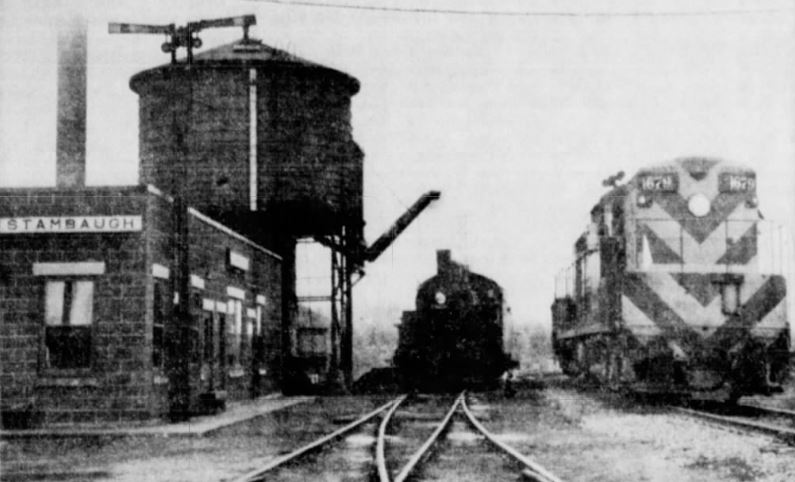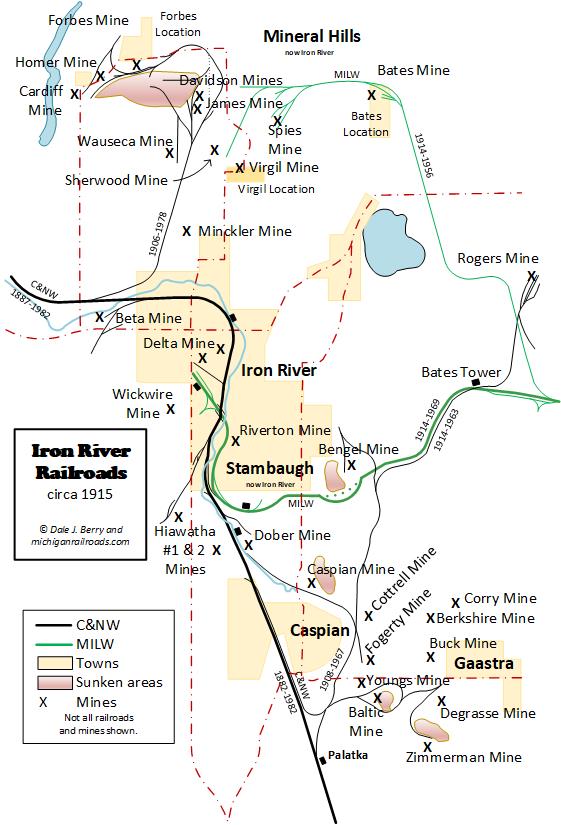- Details
- Hits: 3696
Station: Stambaugh, MI
Stambaugh was platted in 1882 after the Iron River Mine had shown sufficient promise of producing large quantities of ore. The new village was named in honor of John Stambaugh, the president of the Todd, Stambaugh Company of Youngstown, Ohio which had recently acquired the rights to the Iron River Mine. In 1890, the town was incorporated as a village and a water system was installed.
Photo Info: A photo of the Stambaugh depot and water tower in 1955, showing both steam and diesel locomotives. [Escanaba Daily News archives]
Notes
At the turn of the century, the population of Stambaugh was 695. In the early 20th century, Stambaugh had five mines. Electricity was brought in by the Menominee Range Power and Development Company. Telephone lines were installed in 1898 by Michigan Bell Telephone Company. In 1923, the town was incorporated as a City. The population peaked in 1930 at 2,400, but declined as mining declined. In 2000, the town was merged into Iron River. [Iron County Historical Society information]
The MILW depot at Stambaugh was just west of Lay Street, north of the Dober Mine location. [SBM-1928]. An overhead view on Google maps suggests that the foundation for the depot may still exist next to the former right-of-way in a junk yard. The location is 465 feet south of the south end of the runway at Stambaugh airport. Note: This is separate from the MILW's depot at Iron River which is 1.1 miles north.
Stambaugh was the major marshalling yard for Iron River, Mineral Hills, Caspian and Gaastra mines. Local switchers based in Stambaugh served the mines, and brought loaded ore cars back to Stambaugh. Trains were then sent from here east to the docks at Escanaba.
After the C&NW and MILW created an ore transport pact in the early 1930's, MILW ore loads were also brought here. Trains to and from Escanaba used both CNW and MILW power and crews. Local freight and passenger trains were not part of the ore pact, and each railroad handled these services independently.
The MILW branch from Crystal Falls to Stambaugh was abandoned and removed in 1969. The C&NW line was removed in 1982. [MRL], ending railroad service. Stambaugh was merged with Iron River in 2000.
The MILW had two bridges north of Stambaugh, crossing over the CNW main line at milepost 26.1 and 26.2. [MRL]
The telegraph call for MILW's office was "SM". [ETT]
Time Line
1913. November. The construction of the Stambaugh [sic] depot of the CM&StP railway was started this week. It is expected that the building will be completed and the line put in operation as far as Stambaugh before cold weather sets in. Only about a half mile of track has yet to be laid before the line will be completed to Iron River. The trestle over the Northwestern tracks and the highway which skirts the hill there will have to be erected to complete the new railroad. [DD-1913-1115]
1918. MILW had a station agent here on the day shift. At $120 per month, it was one of the highest paid agents in the Milwaukee system. The C&NW had telegraph operators here on all shifts. [TRT]
1923. March. The Northwestern plow that is stationed at Stambaugh broke through the big snow drifts and opened the road. The region has been stopped due to a bad snow storm. Mail and express service has been delayed. A Milwaukee Road plow from Channing to Iron River made a round trip, opening things up. [DD-1922-0303]
1923. May 25. Flames Destroy Stambaugh Station. The Northwestern railroad company's station at Stambaugh was completely destroyed by fire, of unknown origin Wednesday morning. The building was of frame construction, with quarters for telegrapher, waiting room, and freight storage warehouse. [BH]
1930. Workmen for the Milwaukee railway have raised the overhead railroad bridge which spans the road between Stambaugh city and the Stambaugh Northwestern station, a matter of 15 inches, and they widened the right of way considerably by removing the upright posts beneath the bridge and setting them further apart. The city will likely widen and straighten the road. The raising also necessitated the raising of the east end of the "big" bridge over the Northwestern tracks in order that the grade would be uniform. [IDG-1930-1029]
1939. Workmen for the contracting firm of Morrison and Dougherty, of St. Paul, have begun building a new roadbed for the Milwaukee Road where it passes near the Bengal mine in Stambaugh city. The Vernona Mining Co., operators of the Bengal, has served notice that developments at the mine make it necessary for the tracks to be moved. The new line will turn south at a point east of the Bengal, make a sort of semi-circle near the Tully location and then connect with the present track near the overhead bridge just east of the St. Paul depot. It will require two or three weeks to build the track, but there will be no interruption in service. [IDG-1939-0526]
1946. A hotel costing about $25,000 will be erected probably next spring near the old Stambaugh depot by the North Western railroad. Plans for the proposed two story frame structure, 62 by 32 feet, have been drafted by E. C. Vandenburgh, Chicago, chef engineer for the C&NW. It was learned yesterday that the railroad is having difficulty purchasing a site, but it is expected one will be secured within a month. Specifications provide for a lounge, lunch room, kitchen,, shower and lavatory facilities and several bedrooms and lavatory on the second floor. A full basement with heating plant and storage space is also in the plans. The hotel would be used by railroad men who work in the Stambaugh yards during ore shipping season and for train crews remaining here overnight between runs. The hotel will replace several old cars now used as lunch rooms and sleeping quarters. [EDP-1946-1107]
1959. January 3. Railroad Asks Change of Track at Stambaugh. Washington (AP) - The Milwaukee Road has asked the Interstate Commerce Commission for authority to relocate it operations in the vicinity of Iron River and Stambaugh.
The company proposes to abandon about two miles of trackage in and around Stambaugh because it has been advised than an iron ore mining operation is approaching the right of way with threat of cave ins.
The Milwaukee has contracted with the Chicago & Northwestern Railway for use of about five miles of its tracks as a substitute route between Stambaugh and Iron River. [IDG]
1969. The MILW branch from Crystal Falls to Stambaugh was abandoned and removed.
1982. The C&NW line was removed, ending railroad service [MRL]
2000. Stambaugh was merged into Iron River.
Map
Iron River Map
Bibliography
The following sources are utilized in this website. [SOURCE-YEAR-MMDD-PG]:
- [AAB| = All Aboard!, by Willis Dunbar, Eerdmans Publishing, Grand Rapids ©1969.
- [AAN] = Alpena Argus newspaper.
- [AARQJ] = American Association of Railroads Quiz Jr. pamphlet. © 1956
- [AATHA] = Ann Arbor Railroad Technical and Historical Association newsletter "The Double A"
- [AB] = Information provided at Michigan History Conference from Andrew Bailey, Port Huron, MI



